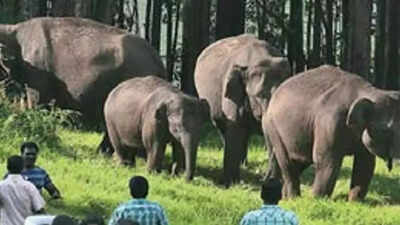ARTICLE AD BOX

Wild elephants are dying like never before in Kerala's forests - 827 deaths in just six and a half years. While many of these animals died from natural causes, far too many were cut short by human aggression: live wires, poisoned bait, hidden explosives and speeding vehicles.
Forest department data attribute 84 of these deaths to human hands.

The numbers reveal a disturbing trend. In 2019, 12 wild elephants fell prey to human aggression; by 2024, the toll climbed to 18. What is even more troubling is that the department has categorised 17 wild deaths during this period as "unnatural" - parlance for deaths warranting further investigation.This Aug, a grim episode unfolded in the Malayattoor forest division of Ernakulam.
Carcasses of nine wild elephants - five of them after Aug 12 - were washed ashore in the Pooyamkutty river. At first, forest officials suspected a flash flood had swept away a herd. But as the toll mounted, doubts deepened. On Monday, the department constituted an 11-member special investigation team and directed it to report within a month.The division used to witness around three wild elephant deaths a year due to flash floods, but this is the first time nine deaths were reported in Malayattoor in less than a month," an official said.
If Malayattoor raised alarms, what happened earlier this year in the Nilambur forest range of Malappuram offered proof of human interference. On Feb 27, veterinary doctors were summoned to the forest edge in Cholamunda village, where an adult tusker known locally as 'Kaserakomban' lay dead in a shallow pit. Outwardly, the carcass seemed unremarkable, but doctors carried out forensic checks and shifted the body for autopsy.
As they passed a metal detector over the tusker’s neck, it beeped. “We cut open the portion and found an oval-shaped metal body lodged under its skin,” an official said.Officials admit that elephants venturing into human habitats or fringe areas where crops are farmed do not survive above the adult stage. "It is found that most of the mortality is reported among juveniles. In places near human habitats, they do not survive above their prime age due to retaliatory action by people who resort to electrocuting or poisoning them.
That's why we capture them when conflicts are reported and relocate them," one of them said.They also cited widespread electrocution incidents in Wayanad, a highly forest-fragmented district. "As many as 24 wild elephants fell to electrocution by people in Wayanad in the past 10 years," an officer said.However, the govt has failed miserably in curbing the mysterious deaths of wild elephants — or to bring the culprits to book — even as a concerted effort to kill the animals is suspected in the high ranges.
In Athirapally, where the picturesque waterfalls draw thousands of visitors each year, a wild elephant was spotted in February with a deep wound on its forehead. As its condition worsened, forest officials tranquilised the animal and shifted it to a rehabilitation centre.
Two days later, it was dead. No case was registered. The wound was officially attributed to “infighting.”Anvar Sadath Kainote, an environmental activist in Nilambur, alleged that the forest department itself fudged post-mortem reports of wild elephants.
"The autopsy reports mostly attribute the deaths to herpes virus, infighting or fall from the top of the hills. Even poison deaths, wherein local people place insecticide in pineapple, are attributed to diseases. In the Karulai range alone, 40 elephants have died in less than five years.
Officials in Nilambur had closed even those complaints submitted to the chief minister without any hearing," he said.Sadath also alleged that people with vested interests were campaigning against efforts to restore an elephant corridor in Pothukallu, where the department had taken over revenue land with central funds.
Both the govt and opposition parties turn a blind eye to such efforts, he said.Elephant experts blame the intelligence wing of the forest department for failing to trace those behind the mysterious deaths of elephants and other wild animals. “When elephants are killed in the aftermath of man-animal conflicts, no investigation takes place,” said Dr P S Easa, member of the Asian Elephant Specialist Group under the IUCN and the National Board for Wildlife.
“What is happening now is that everything is left to the veterinary surgeon who conducts the autopsy.
Most of the time, deaths are written off as ‘unnatural'."According to him, the autopsy of elephants should be done in the presence of an independent elephant expert, as is the practice with tigers. “The department should form a strong team to investigate the mysterious and retaliatory deaths of wild elephants, establish the cause and arrest the culprits.
We need secret agents like the ones in north Indian states, where forest intelligence wings work in coordination across departments and state borders to nab poachers,” he said.The state's high population density and the resultant constructions also pose challenges to wild elephants. A forest officer in a northern district said the investigations were mostly shoddy these days. "Field-level officers are now focused on reducing man-animal conflicts, a direct result of development works carried out in forests, rather than investigations. Wild elephants find it difficult to move through their corridors due to fragmentation caused by infrastructure works, including highways. This forces animals to venture into nearby areas, leading to conflicts. It is not the fault of residents or forest officials; those deciding on such works should take the blame," he said.



.png)
.png)
.png)
















 2 hours ago
3
2 hours ago
3








 English (US) ·
English (US) ·